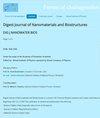Structural, AC conductivity, dielectric and impedance studies of polypyrrole/praseodymium calcium manganite nanocomposites
IF 1
4区 材料科学
Q4 MATERIALS SCIENCE, MULTIDISCIPLINARY
Digest Journal of Nanomaterials and Biostructures
Pub Date : 2023-03-01
DOI:10.15251/djnb.2023.181.343
引用次数: 0
Abstract
In-situ polymerization of a series of nanocomposites viz. 10, 20, 30, 40 and 50 wt % of Praseodymium Calcium Manganite Oxide (Pr0.75Ca0.25MnO3) (PCM) nano manganites in polypyrrole (PPy) were prepared by chemical polymerization technique. The crystalline nature of all the nanocomposites was confirmed by powder X-ray diffraction (XRD). The orthorhombic structure with space group Pnma was confirmed by the well-fitted Rietveld refined XRD data. The average particle size was observed to be in the range of 42 to 60 nm. Scanning Electron Microscope (SEM) confirmed the spherical nature of the particles. The TEM confirmed the crystallinity and Fourier Transform Infra-Red Spectroscopy (FTIR) showed that the stretching frequencies shifted towards higher frequencies for the nanocomposites suggesting better conjugation due to chemical interaction between the PPy and PCM particles. AC conductivity versus frequency showed that at higher frequencies the AC increases obeying Jonscher’s power law. The correlated barrier hopping (CBH) model is therefore used to describe the conduction mechanism. For all composites, the dielectric constant and tangent loss revealed a frequency- and temperaturedependent character. The real and imaginary impedance were both frequency and temperature dependent. The impedance data were analyzed by fitting Nyquist plots using ZsimpWin software which confirmed non Debye type of behavior. This study highlights on the interactions between conduction processes, grain boundaries, and grains.聚吡咯/镨钕钙锰酸盐纳米复合材料的结构、交流电导率、介电和阻抗研究
采用化学聚合技术,在聚吡啶(PPy)中原位聚合制备了重量为10、20、30、40、50 wt %的氧化镨钙锰酸盐(Pr0.75Ca0.25MnO3) (PCM)纳米锰酸盐系列复合材料。通过粉末x射线衍射(XRD)证实了复合材料的结晶性。通过拟合良好的Rietveld细化XRD数据证实了具有空间群Pnma的正交结构。平均粒径在42 ~ 60 nm之间。扫描电子显微镜(SEM)证实了颗粒的球形性质。透射电镜(TEM)和傅里叶变换红外光谱(FTIR)显示,纳米复合材料的拉伸频率向更高的频率移动,表明由于PPy和PCM颗粒之间的化学相互作用,纳米复合材料具有更好的共轭性。交流电导率随频率的变化表明,在较高的频率下,交流电的增加符合琼舍尔幂定律。因此,相关势垒跳跃(CBH)模型被用来描述传导机制。对于所有复合材料,介电常数和切线损耗显示出频率和温度依赖的特征。实阻抗和虚阻抗都与频率和温度有关。利用ZsimpWin软件拟合Nyquist图对阻抗数据进行分析,证实非Debye型行为。本研究重点研究了传导过程、晶界和晶粒之间的相互作用。
本文章由计算机程序翻译,如有差异,请以英文原文为准。
求助全文
约1分钟内获得全文
求助全文
来源期刊

Digest Journal of Nanomaterials and Biostructures
工程技术-材料科学:综合
CiteScore
1.50
自引率
22.20%
发文量
116
审稿时长
4.3 months
期刊介绍:
Under the aegis of the Academy of Romanian Scientists
Edited by: -Virtual Institute of Physics operated by Virtual Company of Physics.
 求助内容:
求助内容: 应助结果提醒方式:
应助结果提醒方式:


